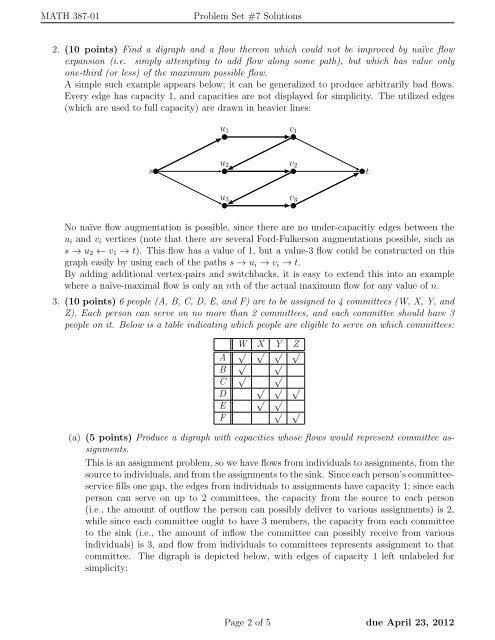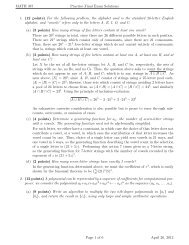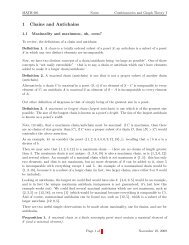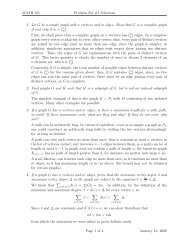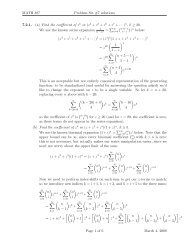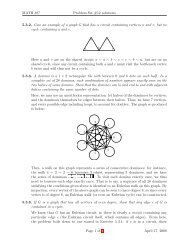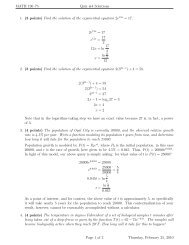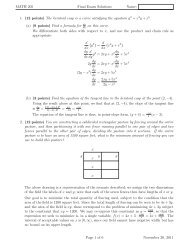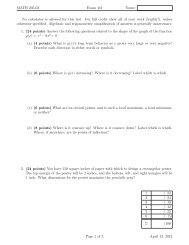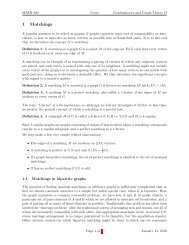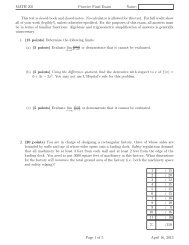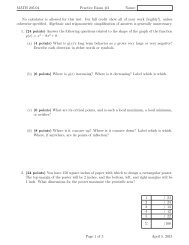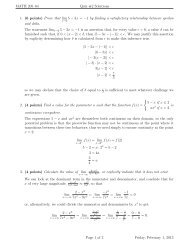MATH 387-01 Problem Set #7 Solutions 1. (10 points) Demonstrate ...
MATH 387-01 Problem Set #7 Solutions 1. (10 points) Demonstrate ...
MATH 387-01 Problem Set #7 Solutions 1. (10 points) Demonstrate ...
You also want an ePaper? Increase the reach of your titles
YUMPU automatically turns print PDFs into web optimized ePapers that Google loves.
<strong>MATH</strong> <strong>387</strong>-<strong>01</strong><br />
<strong>Problem</strong> <strong>Set</strong> <strong>#7</strong> <strong>Solutions</strong><br />
2. (<strong>10</strong> <strong>points</strong>) Find a digraph and a flow thereon which could not be improved by naïve flow<br />
expansion (i.e. simply attempting to add flow along some path), but which has value only<br />
one-third (or less) of the maximum possible flow.<br />
A simple such example appears below; it can be generalized to produce arbitrarily bad flows.<br />
Every edge has capacity 1, and capacities are not displayed for simplicity. The utilized edges<br />
(which are used to full capacity) are drawn in heavier lines:<br />
s<br />
u 1<br />
v 1<br />
u 2<br />
v 2<br />
u 3<br />
v 3<br />
t<br />
No naïve flow augmentation is possible, since there are no under-capacitiy edges between the<br />
u i and v i vertices (note that there are several Ford-Fulkerson augmentations possible, such as<br />
s → u 2 ← v 1 → t). This flow has a value of 1, but a value-3 flow could be constructed on this<br />
graph easily by using each of the paths s → u i → v i → t.<br />
By adding additional vertex-pairs and switchbacks, it is easy to extend this into an example<br />
where a naïve-maximal flow is only an nth of the actual maximum flow for any value of n.<br />
3. (<strong>10</strong> <strong>points</strong>) 6 people (A, B, C, D, E, and F) are to be assigned to 4 committees (W, X, Y, and<br />
Z). Each person can serve on no more than 2 committees, and each committee should have 3<br />
people on it. Below is a table indicating which people are eligible to serve on which committees:<br />
W X Y Z<br />
A √ √ √ √<br />
B √ √<br />
C √ √<br />
√ √ √<br />
D<br />
√ √<br />
E<br />
√ √<br />
F<br />
(a) (5 <strong>points</strong>) Produce a digraph with capacities whose flows would represent committee assignments.<br />
This is an assignment problem, so we have flows from individuals to assignments, from the<br />
source to individuals, and from the assignments to the sink. Since each person’s committeeservice<br />
fills one gap, the edges from individuals to assignments have capacity 1; since each<br />
person can serve on up to 2 committees, the capacity from the source to each person<br />
(i.e., the amount of outflow the person can possibly deliver to various assignments) is 2,<br />
while since each committee ought to have 3 members, the capacity from each committee<br />
to the sink (i.e., the amount of inflow the committee can possibly receive from various<br />
individuals) is 3, and flow from individuals to committees represents assignment to that<br />
committee. The digraph is depicted below, with edges of capacity 1 left unlabeled for<br />
simplicity:<br />
Page 2 of 5 due April 23, 2<strong>01</strong>2


